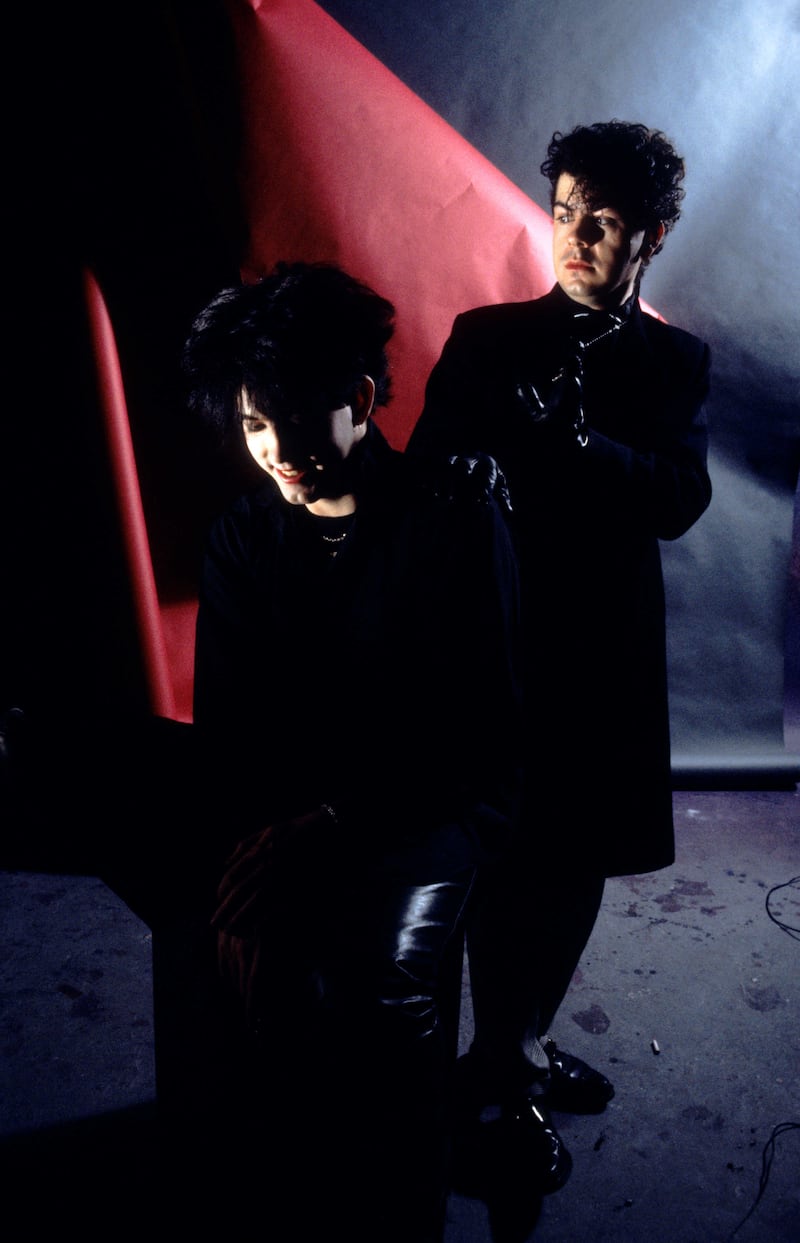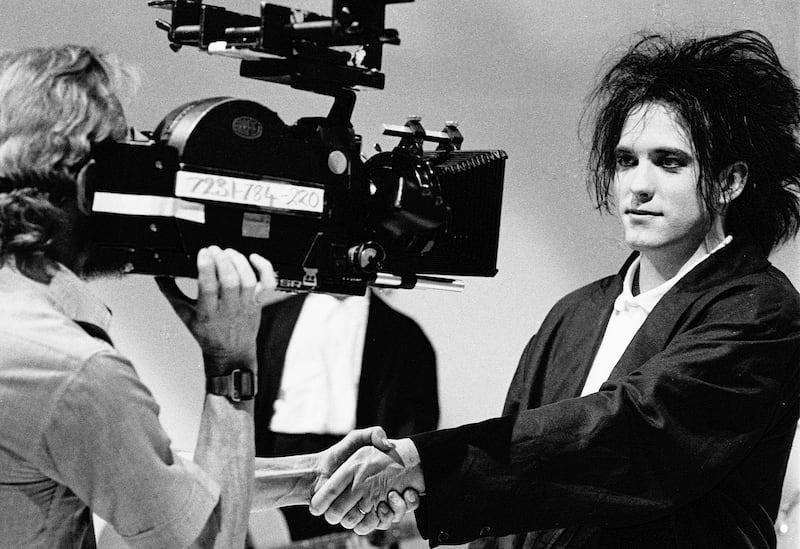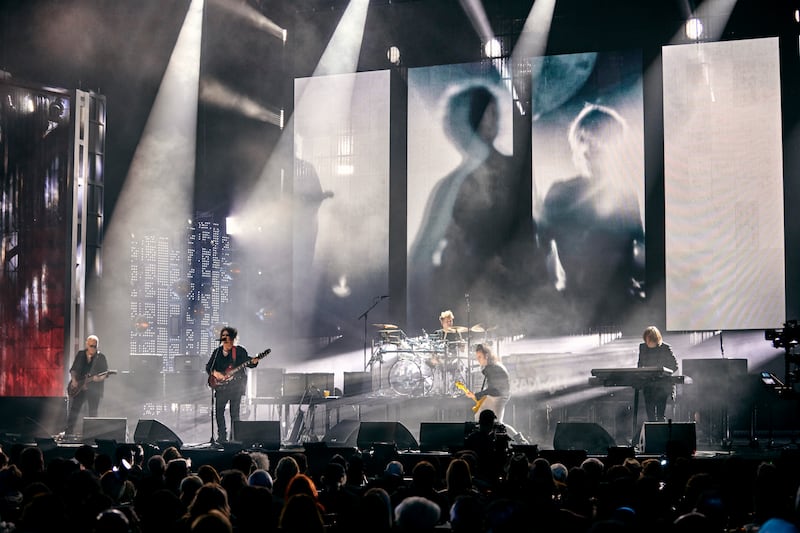There are two kinds of Cure album, the band’s lead singer, Robert Smith, explained recently. The fun, escapist ones that brim with pop hits such as Close to Me and In Between Days. And the heavy, emotionally fraught ones that contemplate the pain of the human condition and the struggle to keep your head up in a world that wants to pull you down. Smith finds the latter by far the more appealing.
“Some Cure albums are put together in a certain way,” he said. “They have an atmosphere. Other Cure albums ... are much more scattered. I prefer the ones that thematically progress.” The heavy records “have more of an emotional core”.
Smith was talking about a trio of LPs in particular: the ghostly Pornography, from 1982, the sad, stately Disintegration, from 1989, and Songs of a Lost World, the group’s upcoming 14th album. All three draw on periods of intense pain and confusion in the life of the frontman, functioning as roadmaps as Smith makes his way from the shadows to the daylight.
During the recording of Pornography, when he was 23, Smith was struggling with excessive LSD and alcohol consumption, coupled with the pressure of building on The Cure’s early success. Disintegration was an even starker chronicling of strife in the band – an instability fuelled by the alcoholism of Lol Tolhurst, Smith’s fellow founding member and one-time best friend, who would be sacked soon afterwards. And now comes Songs of a Lost World, framed by the singer’s grief after the deaths of his parents and his older brother, Richard, and by his general sense of the waters rising as he comes to terms with the ageing process.
READ MORE
“Death and dying becomes more [prevalent] every day, unfortunately. When you’re younger you romanticise it. Then it starts happening to your immediate family and friends. Then it’s a different thing,” the 65-year-old told the BBC presenter Matt Everitt at Abbey Road studios in London.

Songs of a Lost World isn’t just another Cure LP, then. It represents the closing of a circle, the completion of a trilogy that began 42 years ago with Pornography, an experience so fraught Smith almost walked away from music in the immediate aftermath.
The album has been a decade and a half in the making. The earliest material dates from 2010, but the project was given added impetus as the 40th anniversary of The Cure approached, in 2018, and it occurred to Smith that a new LP might be an excellent way to mark that date.
His initial aim was to “do something that sums up what the band is”. But “it was a grand plan – grand plans don’t really work very well. It was a bit triumphal. It was wrong.”
Instead of rushing out the LP for the anniversary, he set most of the tracks to one side and started over. It was a very Cure way of doing things, ignoring commercial expectations and flying by gut instinct.
That resolve is what has made Smith such a consistently engaging and surprising songwriter. Cure fans will have their favourite periods – some prefer the poppy stuff, others the doom-and-gloom years – but Smith has never been predictable, which is why so many have stuck with the band through light and shade, thick and thin.

“The secret of The Cure’s longevity is down to Robert Smith and the fact that he’s never afraid to try different sounds and instruments,” says the Cure connoisseur Jennifer Roche, host of The Grove Radio show on Near FM in Dublin. “He’s very underrated as a guitarist. If you look at many top 10s of great guitarists he rarely gets a mention – but can easily hold his own with the so-called legends of rock.
“He’s a wonderfully accomplished lyricist too. Building atmosphere is a key part of The Cure’s music, whether it’s a fantastical soundscape, a quirky pop song or a dark voyage into bleakness. Smith can always be relied on to set the right tone.”
Smith’s determination to steer his own path was underscored in early 2023 when he risked biting the hand that feeds by criticising Ticketmaster over the “service charges” added to ticket prices for The Cure’s US tour. In speaking out he shamed the company, which is part of Live Nation, into backing down, doing right by his fans and serving as an example to other artists.
[ Oasis, Ticketmaster and the great rock’n’roll swindleOpens in new window ]
His willingness to look beyond the easy pay-day did not emerge out of the blue. That radical strategy of not ripping off fans had already been on display when The Cure played 3Arena in Dublin in December 2022: T-shirts at the merch stall retailed for an entirely reasonable €25 – half what Depeche Mode charged when they performed in Ireland the following summer.
“Smith has always come across as an uncompromising character, and I admire that. His stance on Ticketmaster and the whole dynamic-ticket-pricing saga is particularly admirable. He could have chosen to keep the head down and stay quiet, but he has called it out for what it is: pure greed. And the bands and their management are complicit in that,” says Paul Page, guitarist with the iconic Irish indie band Whipping Boy.
Roche adds: “Smith has always been appreciative of the fans and strives to give value for money at The Cure’s concerts, often playing up to three-hour sets, much to the delight of the audience. So it’s not surprising that he’d call out Ticketmaster on their dubious business model. I hope that more bands and artists will take a similar stance against profiteering.”
Another part of The Cure’s appeal is the fact that Smith’s lyrics speak to universal themes of isolation and despair. In that regard The Cure truly are the sound of the postwar suburbs, having emerged from the grim outer-London commuter town of Crawley, near Gatwick Airport. Many of their fans will have empathised with the frustration and loneliness rattling through songs such as One Hundred Years, a dirge from Pornography about the soul-sapping grind of a factory job. (“It doesn’t matter if we all die…”)
“Crawley is a place where it’s always raining, and a slate grey sky hangs over everything,” Tolhurst wrote in his 2016 autobiography, Cured: The Tale of Two Imaginary Boys. “It is where The Cure was born and always struggled to leave, the place we were never quite able to put behind us. "
Tolhurst could have been talking about any number of small towns anywhere in the world – or, for that matter, anywhere in Ireland. This very specifically English music – roiling with suppressed emotions and polite angst – has always had a universal reach.
“The appeal for many is that it’s very human to go through periods of sadness, be it heartache, loss, mental instability, hedonistic self-destruction,” says Tron Bison, the lead singer of the Belfast goth band Devoted Sinners. “There’s great comfort to be taken in someone else putting these feelings into words better than you ever could. It’s soothing to know someone else has been there. It allows you to feel ‘I’m not alone.’”
The title Songs of a Lost World comes from Smith’s sense that humanity peaked in the mid-1970s and has been in descent ever since. Born in 1959, he was 10 when the moon landing took place. In those days technological advancements promised a bright future. That’s his lost world: a place of optimism quite different from our present-day dystopia.
“I still feel like that 10-year-old kid staring at the moon,” Smith told Everitt. “The world seemed to stall at that moment. I grew up in the glorious 30 years from the end of the second World War. The world I was born into was getting incrementally better. It seemed it was on an upward trajectory. The moon landing was part of that. I turned 16 in 1975, and it seemed like the world stalled and it’s been travelling down ever since. That’s the core ... that’s the beating heart of the album.”
Smith is blessed with immense self-awareness. The Cure may have been tagged as godfathers of goth on their journey to becoming one of the most beloved cult groups of the past 40 years, but he never let the cliche of The Cure as arch-miserabilists consume him. On stage in Dublin two years ago he brought an intensity and grandeur to the music – but between the songs he was chipper and chatty. Those are contradictions with which we can all empathise: we’ve all been mopey one minute and upbeat the next. It’s the human condition in a nutshell – a point Tolhurst reinforces in his book.
“On one hand, Robert is the dark, brooding, creative, melancholic sort. It’s obvious from the way he carries himself that is head is somewhere in the clouds. It’s always been part of his persona: the tortured artist. He’s also quite normal, someone who enjoys sitting down with a pint and watching football ... He’s part of the world but also not part of it.”
That contradiction is what gives The Cure their power and contributes to the magisterial ache of Songs of a Lost World. It’s an imperious album, full of lofty guitar solos and vocals that sound as if they are sweeping down from the top of a craggy mountain range.

But it’s also an everyday cry of pain by a man in late middle age who has lost his parents and a sibling and doesn’t know what to do with the emotions. That’s especially the case on the record’s centre point, I Can Never Say Goodbye, a lament for the singer’s brother that the band had to record several times, as Smith’s earlier vocals were simply too overwrought.
“I wrote the music the day after he died but struggled for a long time to find the right words,” Smith explains in his liner notes. “I finally decided on a simple lyrical narrative of what happened on the last night I was with him. It was a very difficult song to sing on the Shows of a Lost World tour, but always great. Performing it onstage helped me to deal with my grief. I miss him.”
Smith wasn’t just helping himself. The magnificent melancholy of The Cure has been a positive force in the lives of his fans for decades.
“Nobody can be happy and upbeat all the time, so when you’re feeling down or struggling with something in your life, music can be a great comfort,” Roche says. “Listening to melancholy lyrics feels like a form of empathy. It feels as if the musicians understand these emotions you’re feeling. You can’t have light without darkness. One balances out the other. That’s what I love about The Cure’s music: they have both.”
Songs of a Lost World is released on Friday, November 1st



















